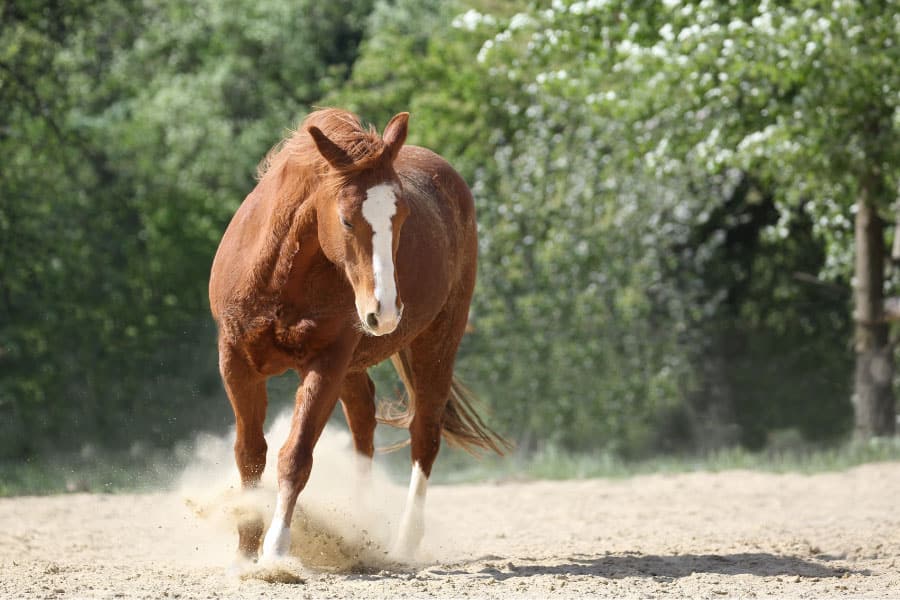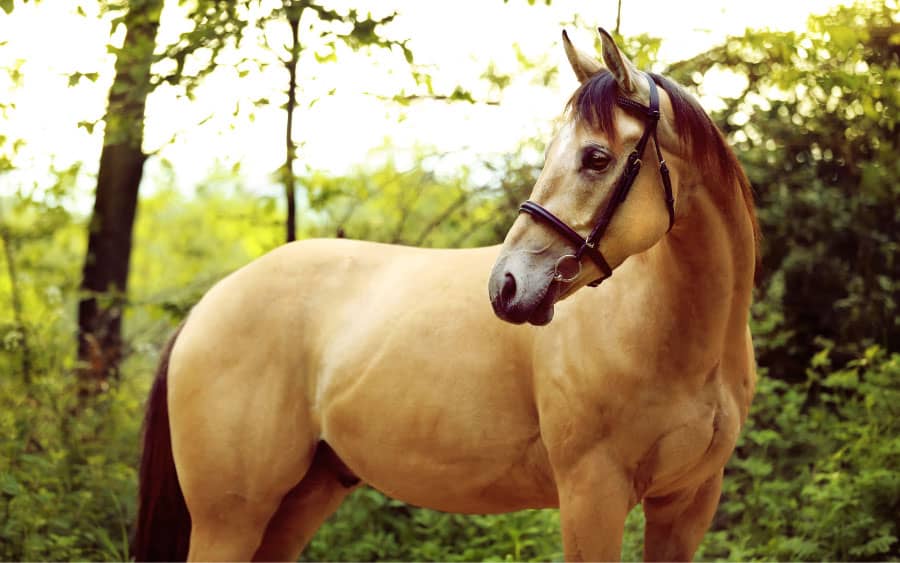- Your source for stall mats, rubber arena footing, arena harrows and arena dust control.

Historically three-phase eventing has been the purvey of long-limbed ultra-fit thoroughbreds. While the past few decades have seen an increase in the number of warmbloods, Anglo-Arabs, and Irish sport horses competing in eventing, few main-book registered quarter horses are participating in the sport.
It is unlikely that a quarter horse conforming to the breed standards set out by the AQHA (American Quarter Horse Association) will be successful in FEI (Fédération Equestre Internationale) graded eventing competitions. Grassroots courses with shorter distances and slower, less challenging elements should be easily accomplishable by most quarter horses.
Appendix Quarter Horses may perform better due to the inclusion of 50% thoroughbred blood. With any sport, there are anomalies, the outlier who defies all norms and expectations. One day we may witness and fall in love with the story of a quarter horse successfully competing in 5-star eventing.
Eventing is a challenge to even the most skilled and athletic horse-rider combinations. It requires bravery, fitness, skill, and “heart.” The athletes are long-limbed, lean, and fearless. Their conformation is almost diametrically opposite to that of a quarter horse bred for cattle work.
The breeding of quarter horses has evolved to meet the highly specific needs of a working ranch. Can the supreme functionality of a working horse be used to navigate the competitive challenges of eventing effortlessly?
What is Eventing?
Eventing is a sub-category of English riding with European origins. It evolved as a military exercise to showcase the ideal cavalry mount, but the sport quickly gained popularity with the public.
The three phases or components of eventing that must be completed are dressage, cross-country, and show-jumping.
The dressage phase tests the obedience, relaxation, balance, strength, and flexibility of the horse. The true masters of dressage cue their horses with such exquisite subtlety that to a spectator, it would seem as though the horse and rider move with one mind.
Cross country is used to determine the horse’s endurance and bravery over solid natural-style fences. The course may range from a minimum of 2.6km in a one-star event to 6.8km in a 5-star event. The majority of the course will be done at a working gallop.
Show-jumping is the last phase and is usually completed the day after the cross country round.
Horses need to be fit, maneuverable, and precise to obtain a penalty-free round over easily knocked jumps.
Ideal Conformation for Eventing vs. Ideal Quarter Horse Conformation
Original Purpose
The most commonly used horse breeds in international eventing are thoroughbreds or warmbloods with a high percentage of thoroughbred blood. Thoroughbreds evolved from coursers in the middle ages and were gradually adapted for flat-racing and steeple-chasing.
In more recent decades, breeders have begun purpose breeding event horses, creating horses ideally suited to meet eventing demands.
Quarter horses evolved as ranch horses to be used for western riding. Breeders focusing on different western disciplines will emphasize different conformation traits; however, they will not deviate substantially from the standard quarter horse conformation outlined by the AQHA.
Height and Speed
Ranch duties require the rider to rapidly get on and off their horse at speed multiple times during the day. Quarter horses with their short, heavily muscled conformation are ideal for this; however, they do not have the reach and ground coverage of taller long-legged thoroughbreds.
An event rider does not need to mount and dismount multiple times; they need a horse that has a ground covering energy-efficient stride. The typical event horse will range between 16.0hh and 17.0hh.
Quarter horses have greater acceleration and speed than thoroughbreds over short distances; however, the average thoroughbred can achieve faster top speeds than a quarter horse and maintain it over a longer distance.
Thus, the thoroughbred’s endurance at high speeds makes them better suited to the distances required for the cross-country phase of eventing and enables the rider to avoid time penalties.
The difference in speed endurance will be most noticeable at the upper levels of competition. Regardless of this, with the correct conditioning, a quarter horse should easily sustain a working gallop over 2-3 km without suffering undue physiological stress.

Hindquarters
The hindquarters of good event horses have a medium slope to the croup with a well-angled low set stifle joint. The angled placement of the hind leg and pelvis allows the horse to bring the hindquarters under their center of gravity and engage the abdominal muscles for collection and extension in dressage.
A strong sacroiliac musculature will protect the horse’s back and spine during the course of its career and allow the horse to create the necessary power to lift the forehand for jumping and dressage.
Quarter horses have large, well-muscled hindquarters, with the hindquarter placed well under the center of gravity.
The stifle and hocks are more angled than an average thoroughbred. This allows the quarter horses to have the rapid acceleration and deceleration necessary for sharp turns and sliding stops.
Due to this conformation, quarter horses often show a poor ability to extend the stride within a gait. They may struggle to get the stride length necessary for combination jumps and extended movements in dressage.
Forequarters and “Uphill” Conformation
Regardless of breed, the successful event horse typically shows a long scapula with the forward placement of the shoulder. This creates an “uphill” conformation, with the center of balance being moved rearward towards the hindquarters.
The hindquarters are responsible for generating the explosive power needed for most equestrian sports, but the hindquarters do not determine the direction in which this power is released; this is governed by the innate balance and forequarter conformation of the horse.
The uphill conformation allows the power generated by the hindquarters to be directed up and out over a jump or through a dressage movement by transferring that power to the forehand via the sacroiliac joint connection. If the horse is built uphill, half the job is already completed, and the strain on the musculoskeletal system is reduced.
A quarter horse also has large sloping shoulders, but the foreleg placement is further back, and the neck inserts into the wither lower down, creating a “downhill” conformation and a forward placement of the horse’s center of gravity.
This conformation is ideal for extreme stops and turns. When applied to eventing, a quarter horse will need to work harder to lift the forehand and move the center of gravity backward.
They will lose the freedom in the shoulder necessary to neatly tuck the front legs up for correct jumping technique and are highly unlikely to have the expression needed to achieve winning marks for dressage.
Temperament
When participating in eventing, it could be argued that the most important aspect of any horse is the temperament. It is ideal to have a high-energy horse who wants to work with you and remains even-tempered and attentive, even in high-excitement situations.
Few people can fault a quarter horse’s temperament. They are level-headed partners who enjoy working with people and show an amazing ability to give speed and explosive energy without excess excitement.
Both quarter horses and thoroughbreds are bred to have “heart.” That elusive quality that allows a horse to show great courage and determination regardless of the challenge facing them. The best eventers have more than enough heart and are true partners to their riders.
Appendix Quarter Horses
50/50 Quarter horse-Thoroughbred crosses are eligible for registration as an Appendix Quarter Horse. Although not technically a purebred quarter horse, these horses will show many desirable traits needed for eventing through the infusion of thoroughbred characteristics.
The increased height and change in forehand conformation may allow the appendix quarter horse to outperform a main book registered quarter horse in eventing.
Conclusion
Quarter horses can event if given the appropriate training and fitness conditioning. Horses conforming to the breed conformation standards are unlikely to be successful at upper-level events.
Appendix quarter horses may have the edge needed to compete at higher levels. If the rider aims to compete in FEI graded five-star competitions, it would be best to select a different breed.
The main purpose of most amateur riders is to have fun with their horse. If they want to try eventing on their quarter horse, then they should go for it. Perhaps they will be the rider horse combination who will set a precedent for quarter horses in international eventing.

